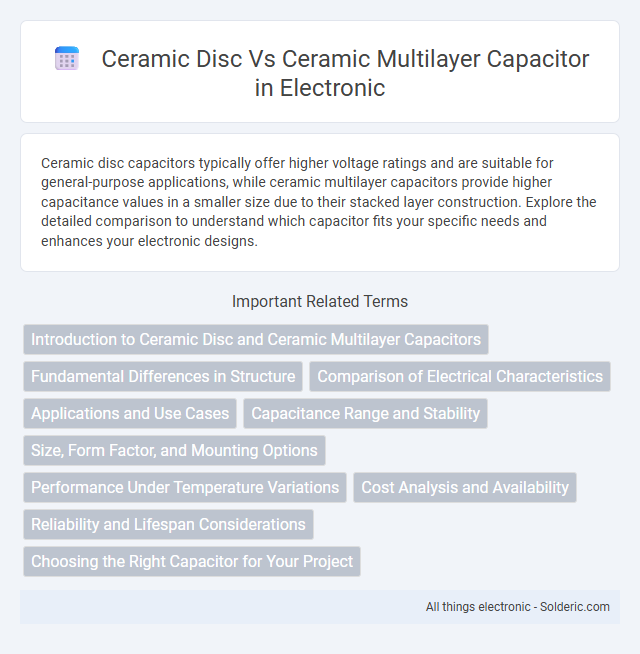Ceramic disc capacitors typically offer higher voltage ratings and are suitable for general-purpose applications, while ceramic multilayer capacitors provide higher capacitance values in a smaller size due to their stacked layer construction. Explore the detailed comparison to understand which capacitor fits your specific needs and enhances your electronic designs.
Comparison Table
| Feature | Ceramic Disc Capacitor | Ceramic Multilayer Capacitor (MLCC) |
|---|---|---|
| Structure | Single ceramic disc with metal electrodes | Multiple alternating ceramic and metal layers |
| Capacitance Range | pF to nF range (typically low capacitance) | pF to uF range (higher capacitance possible) |
| Size | Larger, bulkier | Compact, surface-mount capable |
| Frequency Response | Good for high frequency but limited by size | Excellent high-frequency performance |
| Reliability | Less reliable, more prone to cracking | High reliability, robust design |
| Applications | General purpose, high voltage circuits | High-density electronics, SMD circuits |
| Cost | Generally lower cost per unit | Higher cost but better performance |
Introduction to Ceramic Disc and Ceramic Multilayer Capacitors
Ceramic disc capacitors consist of a single ceramic dielectric layer sandwiched between metal electrodes, typically used for high-frequency applications due to their low inductance and stable capacitance values. Ceramic multilayer capacitors (MLCCs) feature multiple alternating layers of ceramic dielectric and metal electrodes stacked together, enabling higher capacitance in a compact form factor, commonly utilized in modern electronic circuits for decoupling and filtering. Both capacitor types employ ceramic materials but differ significantly in construction, capacitance range, and application versatility.
Fundamental Differences in Structure
Ceramic disc capacitors consist of a single ceramic dielectric disc with metal electrodes on both sides, offering simplicity and high voltage tolerance. Ceramic multilayer capacitors (MLCCs) feature multiple alternating layers of ceramic dielectric and metal electrodes stacked to create higher capacitance in a smaller volume. The multilayer structure provides superior capacitance density and improved performance in high-frequency applications compared to the single-layer design of ceramic disc capacitors.
Comparison of Electrical Characteristics
Ceramic disc capacitors typically exhibit higher Equivalent Series Resistance (ESR) and lower capacitance stability compared to ceramic multilayer capacitors (MLCCs), which offer superior capacitance values and low ESR due to their multilayer construction. MLCCs provide better high-frequency performance and lower inductance, enhancing signal integrity in high-speed electronic circuits. Your choice between these capacitors should consider the specific electrical parameters such as dielectric constant, tolerance, and temperature coefficient relevant to your application's frequency and stability requirements.
Applications and Use Cases
Ceramic disc capacitors are commonly used in high-frequency applications like radio frequency circuits and audio signal processing due to their low inductance and stable performance. Ceramic multilayer capacitors (MLCCs) excel in decoupling, filtering, and bypassing tasks within power supply circuits and consumer electronics, offering compact size and high capacitance values. Your choice between these capacitors depends on the specific application requirements, such as frequency range, capacitance, and space constraints.
Capacitance Range and Stability
Ceramic disc capacitors typically offer lower capacitance values, usually ranging from a few picofarads up to around 1 microfarad, with moderate stability across temperature variations. Ceramic multilayer capacitors (MLCCs) provide a much broader capacitance range, from picofarads up to tens of microfarads, and exhibit superior stability due to advanced dielectric materials like X7R or C0G/NP0. Your choice between the two depends on the required capacitance range and the need for stable performance in varying environmental conditions.
Size, Form Factor, and Mounting Options
Ceramic disc capacitors typically have a larger and bulkier form factor compared to ceramic multilayer capacitors (MLCCs), which are compact and designed for surface mounting. MLCCs offer a smaller footprint and are ideal for high-density circuit boards due to their rectangular shape and standardized sizes in metric codes. If you need space-saving and automated assembly options, ceramic multilayer capacitors provide more efficient mounting solutions than the through-hole ceramic disc capacitors.
Performance Under Temperature Variations
Ceramic disc capacitors exhibit stable capacitance but may suffer from higher losses and reduced insulation resistance at elevated temperatures, impacting performance consistency. Ceramic multilayer capacitors (MLCCs) demonstrate superior temperature stability with minimal capacitance variation and low equivalent series resistance (ESR), making them ideal for precision applications. Their multilayer structure enhances thermal management, ensuring reliable performance across wide temperature ranges.
Cost Analysis and Availability
Ceramic disc capacitors generally offer lower cost and higher availability due to their simple construction and widespread use in basic electronic applications. Ceramic multilayer capacitors (MLCCs) tend to be more expensive but provide better performance characteristics, making them ideal for advanced and high-frequency circuits. Market demand for MLCCs has increased significantly, sometimes causing supply constraints and price fluctuations compared to the more readily available ceramic disc capacitors.
Reliability and Lifespan Considerations
Ceramic disc capacitors typically exhibit lower reliability and shorter lifespan compared to ceramic multilayer capacitors due to their simpler construction and higher susceptibility to mechanical stress and aging. Ceramic multilayer capacitors offer enhanced reliability through their multi-layered design, which improves capacitance stability and resistance to thermal and electrical stress over prolonged use. Understanding these distinctions helps you select the most suitable capacitor type for high-reliability and long-lifespan applications.
Choosing the Right Capacitor for Your Project
Selecting the right capacitor for your project depends on performance requirements and application specifics. Ceramic disc capacitors excel in high-voltage applications and offer durability with low cost, while ceramic multilayer capacitors (MLCCs) provide higher capacitance in a compact size and perform well at high frequencies. Understanding these differences helps you optimize circuit design by balancing size, capacitance, and voltage tolerance.
Ceramic disc vs ceramic multilayer capacitor Infographic

 solderic.com
solderic.com